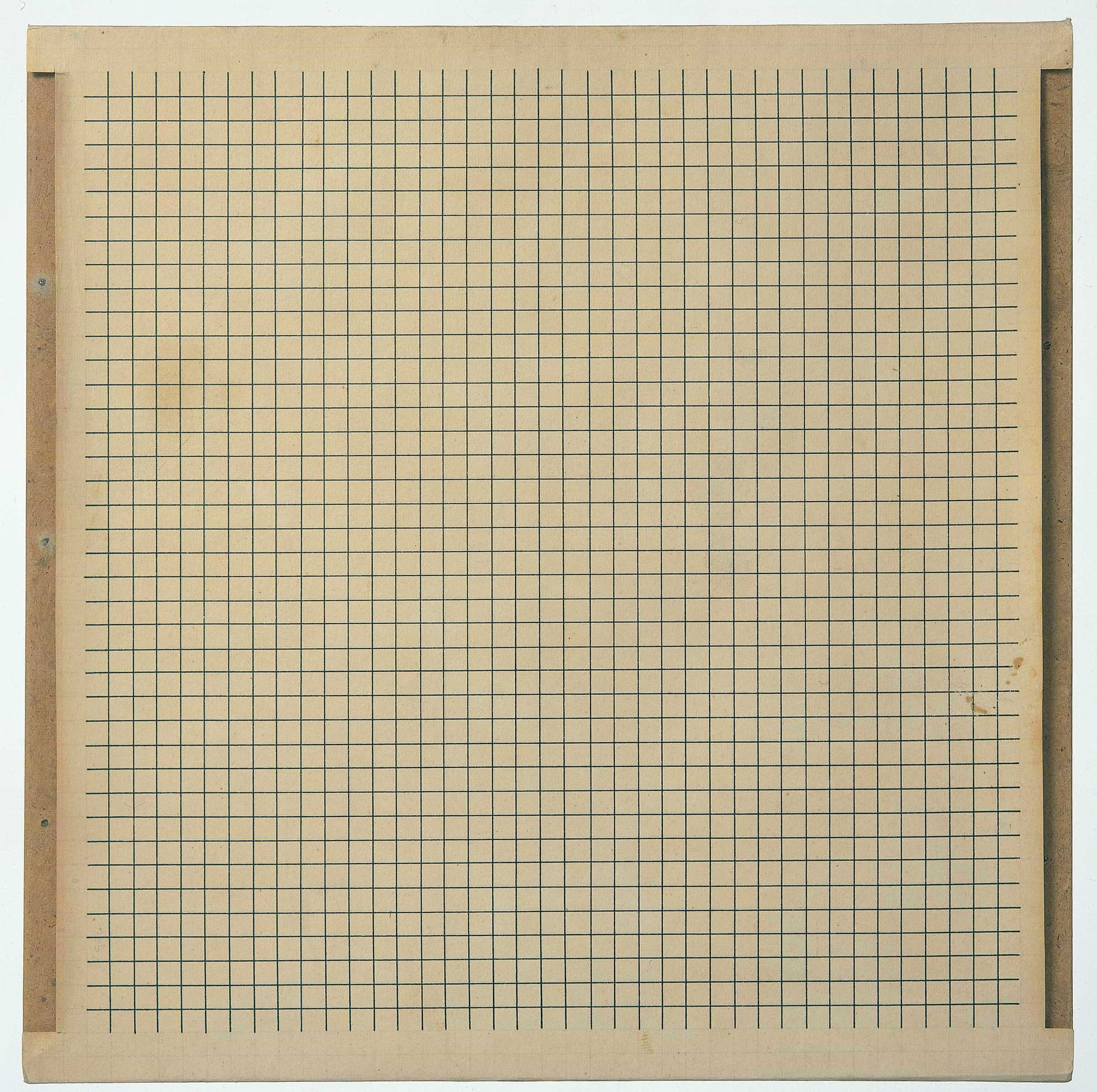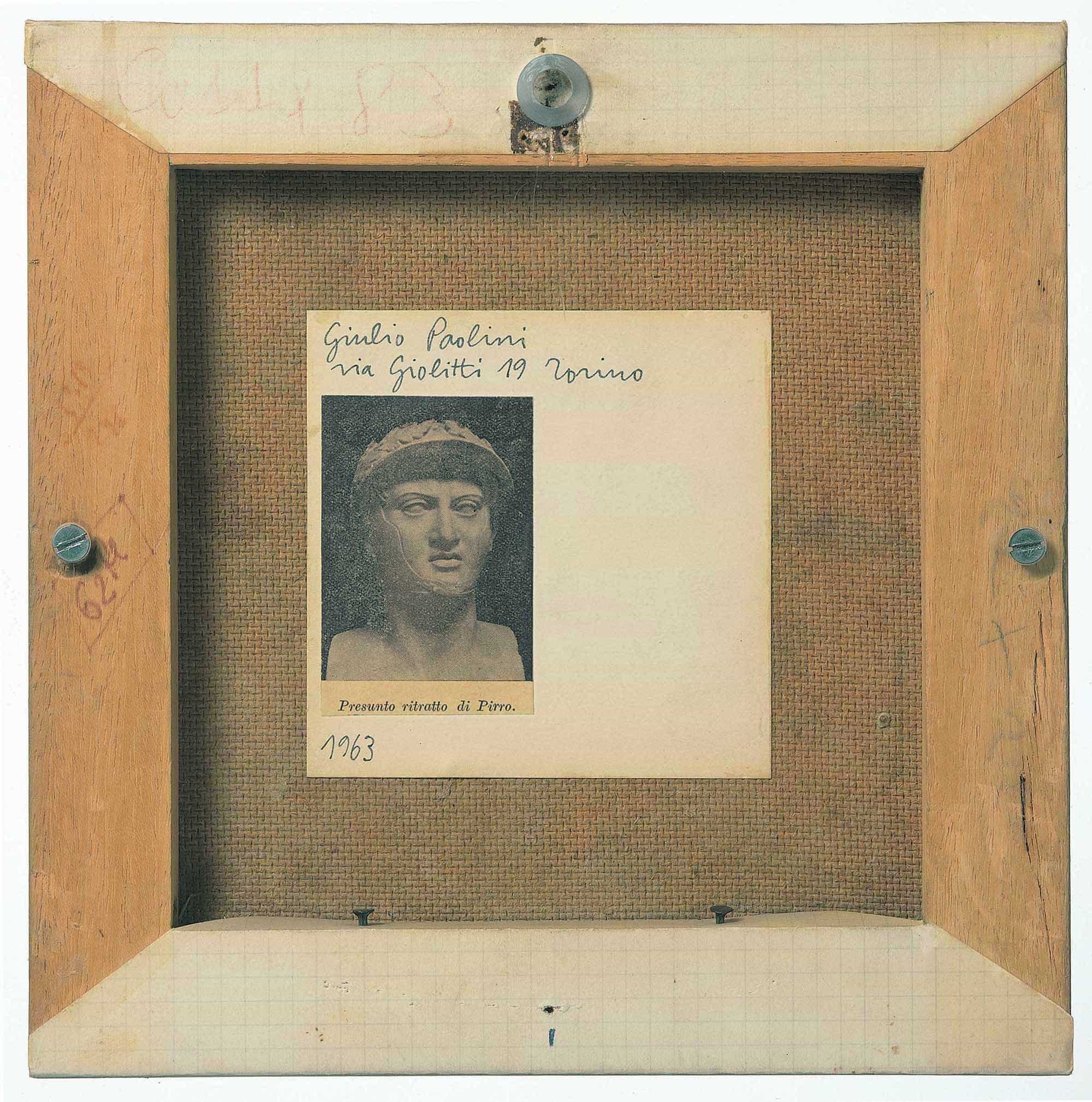Presunto ritratto di Pirro, 1963
GPO-0030
Alleged portrait of Pyrrhus
Ink on squared paper laid down on masonite panel
22 x 22 cm
Signed and dated on the verso on a white paper square: “Giulio Paolini / via Giolitti 19 Torino” (upper left), “1963” (lower left)
Private collection, Turin
A grid drawn with black ink traces over the pre-existing squares on the sheet on which it is delineated, leaving the border visible on all four sides. The sheet is trimmed along the right and left edges so that the masonite support remains visible. On the verso is a reproduction of a classical bust, identified by the caption as "Alleged portrait of Pyrrhus".
This work is part of a group of works (from GPO-0028 to GPO-0049) whose common denominator is the presence of an intervention on both the recto and the verso of the painting. Surfaces of various types take turns appearing on the recto (painted paper, graph paper, photographic reproductions, shaped wooden panels), while on the verso (hidden from view) we find the details of images and printed words taken from magazines or from books. The title, when specified, refers to a textual element present on the verso. The artist explains that: “Just as on the surface various elements alternate amongst themselves, but always remain ‘blind’, in the sense that they tend not to supply an image, but are there for their own sake, occupying that given space, so the title itself is absolutely autonomous with respect to the surface [...], constituted by a fragment of words and, at times, images, following the signature and the date, on a white paper square on the back of the picture” (1972).1 The subtraction of the painting from its function as a vehicle for an image is a continuation of the study experimented with in some previous works that focus on a subject that, albeit mentioned, remains an unexpressed presence: the title refers to something that isn't visible (in that it is applied to the verso), while the recto presents a mute image or in any case one that is free from any rational relationship with the title.
The unrelated components of a painting call into play the very concept of a painting, as Paolini states in regard to this work: “I liked the title because the painting was precisely, in a certain sense, an alleged whole".2
1 G. Paolini in G. Celant, Giulio Paolini (New York: Sonnabend Press, 1972), p. 34 (revised translation, republished in Giulio Paolini 1960-1972, edited by G. Celant [Milan: Fondazione Prada, 2003], p. 122), reprint (Cinisello Balsamo: Silvana Editoriale, 2019), p. 34. Cf. also the artist's remarks in C. Lonzi, Autoritratto (Bari: De Donato Editore, 1969), p. 367, reprint (Milan: Et al./Edizioni, 2010), p. 280, English edition (Brussels-London: Divided Publishing, 2021), p. 320.
2 Ibid., p. 34 (revised translation).
| 1992-93 | Paris, Galerie Di Meo, Giulio Paolini. Œuvres de 1963 à 1978, 27 November 1992 - 30 January 1993, cited in the checklist of exhibited works no. 1 p. 66, col. repr. pp. 16-17 (recto and verso), referred to in the text by F. Poli pp. 6-8. |
| 1999 | Turin, GAM Galleria Civica d’Arte Moderna e Contemporanea, Giulio Paolini. Da oggi a ieri, 8 May - 25 July, cited in the checklist of exhibited works no. 29 p. 38, repr. p. 11 (recto and verso), referred to in the text by P.G. Castagnoli p. 13. |
| 2017-18 | San Secondo di Pinerolo (Turin), Castello di Miradolo, Fondazione Cosso, Fausto Melotti. Il canto della luce, 11 November 2017 - 20 February 2018, col. repr. pp. 142-143. |
| • | G. Paolini in G. Celant, Giulio Paolini (New York: Sonnabend Press, 1972), pp. 30-31; republished in Giulio Paolini 1960-1972, edited by G. Celant (Milan: Fondazione Prada, 2003), p. 122; reprint (Cinisello Balsamo: Silvana Editoriale, 2019). |
| • | G. Celant, Giulio Paolini (New York: Sonnabend Press, 1972), pp. 30-31, repr. no. 24 p. 32 (recto and verso); republished in Giulio Paolini 1960-1972, edited by Id. (Milan: Fondazione Prada, 2003), pp. 110, 122; reprint (Cinisello Balsamo: Silvana Editoriale, 2019). |
| • | M. Fagiolo, "Glossario", in Giulio Paolini (Parma: Università di Parma, Centro Studi e Archivio della Comunicazione, 1976), p. 24, repr. nos. 27-28 (recto and verso). |
| • | A.C. Quintavalle, "Paolini: scritture", ibid., p. 53. |
| • | S. Isler, Del bello intelligibile. Semiotische Analyse zu sechs Werken von Giulio Paolini, PhD dissertation (Zurich: Philosophische Fakultät I der Universität Zürich, 1983), pp. 148-163, not repr. |
| • | F. Poli, "Note di lettura", in Id., Giulio Paolini (Turin: Lindau, 1990), p. 25, not repr.; republished in Giulio Paolini. Von heute bis gestern / Da oggi a ieri, exhibition catalogue, Graz, Neue Galerie im Landesmuseum Joanneum (Ostfildern-Ruit: Cantz Verlag, 1998), p. 39, not repr. |
| • | F. Poli, in Forma italiana – Individualità. Salvatore Astore, Roberto Caracciolo, Carlo Ferraris, Nunzio, Luisa Protti, Fabrizio Sibona, Luigi Stoisa, Marco Tirelli, exhibition catalogue, Cuneo, Galleria Confini Arte Contemporanea, 1993, col. repr. p. 21 (recto and verso). |
| • | Giulio Paolini 1960-1972, op. cit. (Milan: 2003), repr. pp. 72-73 (recto and verso). |
| • | A. Rabottini, "La passione trasparente. Note sull’arte di Giulio Paolini, emergenze recenti ecc.", in Giulio Paolini. Fuori programma, exhibition catalogue, Bergamo, GAMeC Galleria d’Arte Moderna e Contemporanea (Cinisello Balsamo: Silvana Editoriale, 2006), repr. p. 26 (recto and verso). |
| • | M. Disch, Giulio Paolini. Catalogo ragionato 1960-1999, vol. 1 (Milan: Skira editore, 2008), cat. no. 30 p. 68, col. repr. (recto and verso). |
| • | C. Zambianchi, "Riflesso nel tempo. Note sul senso della storia nell’opera di Giulio Paolini", in S. Bann et al., Il passato al presente. In tema 2 (Turin-Mantua: Fondazione Giulio e Anna Paolini and Corraini Edizioni, 2016), p. 14, col. repr. p. 13 (recto and verso). |
| • | D. Soutif, "Filigrane. Paolini, il primo quadro e la storia dell’arte", ibid., pp. 92, 94; republished in French in Les Cahiers du Musée national d’art moderne 137 (Paris), Autumn, 2016, p. 79, repr. pp. 78 (recto), 79 (verso). |



